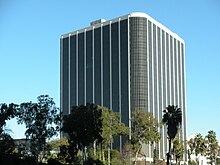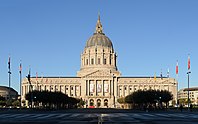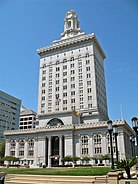Local government in California
The
Due to geographical variations in property tax and sales tax revenue (the primary revenue source for cities and counties) and differing attitudes towards priorities, there are variations in the levels of various services from one city to the next.
Article 2, Section 6, of California's constitution provides that elections for county, city, school, and judicial offices are officially non-partisan and political party affiliations are not included on local election ballots.
Counties
The basic political subdivision of California are the 58
County government
Fourteen counties
County congestion management agencies or designees are responsible for comprehensive transportation improvement programs that reduces traffic congestion and transportation-related air pollution. Los Angeles, Orange, Riverside, and San Bernardino counties have county transportation commissions responsible for planning and coordinating transportation services and projects.[11]

County courts
California's judicial system is organized along county lines, but the
County grand juries

California also uses grand juries, with at least one per county.[12] These county-level grand juries are often called civil grand juries because their primary focus is on oversight of government institutions at the county level and lower. They meet at least once per year.
LAFCOs
Because of historical problems with fragmentation of local government as a result of the formation of too many special districts by enthusiastic local officials, all counties currently have a corresponding
History
On January 4, 1850, the California constitutional committee recommended the formation of 18 counties. They were Benicia, Butte, Fremont, Los Angeles, Mariposa, Monterey, Mount Diablo, Oro, Redding, Sacramento, San Diego, San Francisco, San Joaquin, San Jose, San Luis Obispo, Santa Barbara, Sonoma, and Sutter. On April 22, the counties of Branciforte, Calaveras, Coloma, Colusi, Marin, Mendocino, Napa, Trinity, and Yuba were added. Benicia was renamed Solano, Coloma to El Dorado, Fremont to Yolo, Mt. Diablo to Contra Costa, San Jose to Santa Clara, Oro to Tuolumne, and Redding to Shasta. One of the first state legislative acts regarding counties was to rename Branciforte County to Santa Cruz, Colusi to Colusa, and Yola to Yolo. The last county in California to be established is Imperial County on August 7, 1907.
Since 1911, counties in California have been allowed limited
Municipalities
As of Jan 26, 2022, there were 482 incorporated municipalities in the state.[17] Under California law, the terms "city" and "town" are explicitly interchangeable; the name of an incorporated municipality in the state can either be "City of (Name)" or "Town of (Name)".[18] Counties exercise the powers of cities in unincorporated areas.[3]
Municipal government
| City | Government |
|---|---|
| Los Angeles | Government of Los Angeles |
| San Francisco | Government of San Francisco |
| San Jose | Government of San Jose
|
| Sacramento | Government of Sacramento |
California municipalities are either charter or general-law. General-law municipalities have powers defined by the state's Government Code;[note 3] charter municipalities may have increased powers, but the adoption or amendment of a city charter requires a popular vote. Most small cities have a council–manager government, where the elected city council appoints a city manager to supervise the operations of the city. Some larger cities have a mayor–council government, with a directly-elected mayor who oversees the city government. In many council–manager cities, the city council selects one of its members as a mayor, sometimes rotating through the council membership—but this type of mayoral position is primarily ceremonial.
Municipal services
Incorporated cities and towns have the power to levy taxes.
Residents of a sufficiently large piece of unincorporated county land can incorporate a city. The city government then takes some of the tax revenue that would have gone to the county, and can impose additional taxes on its residents. It can then choose to provide almost all the services usually provided by the county (and more), or provide only a few and pay the county to do the rest. A city in this last arrangement is called a contract city; this type of contract is generally known among lawyers as the "Lakewood Plan", because it was pioneered by the city of Lakewood in 1954.[21]
School districts
Primary and secondary

California school districts may be organized as elementary districts, high school districts, unified school districts combining elementary and high school grades, or community college districts.[22] Union districts are formed by joining two or more elementary districts.[22] School districts are governed by an elected school board (sometimes called a "board of education" or "board of trustees"), which manages the schools within its jurisdiction.[22] There are also county special service schools and regional occupational programs provide vocational and technical education.[22] Historically, school districts were organized at the primary level (Kindergarten through 8th grade, approximately ages 5–13), and the secondary (high school) level (9th through 12th grade, approximately ages 14–17).
School district and community college district boards may determine their own fiscal requirements—the counties levy and collect the taxes required, possibly subject to constitutional tax limitations and voter approval.[22] Historically, school districts were funded through local property tax revenue, but due to Serrano v. Priest, school districts are funded through the State government through various funding formulas that allocate local property tax revenues and other revenue.
Community colleges
The State of California operates the University of California and the California State University as statewide systems. However, community colleges, which provide the first two years of post-secondary education and adult vocational courses, are organized in community college districts, which operate one or more community colleges within their jurisdiction. Community college districts in California are governed by elected boards.

California's first community colleges were established as extensions of high schools.
Special districts
A

Independent special districts have elected boards. Dependent special districts are governed by the city or county that created them. Regional bodies have boards appointed by the city and county governments they encompass. Some districts, often referred to as assessment districts, have voting based on the assessed values of the property contained within the district, rather than a popular vote; that practice was ruled constitutional for districts that provide benefits to the land in rough proportion to the value of the land, rather than to people within the district.[note 4] Districts are categorized as enterprise districts and non-enterprise districts. Enterprise districts operate as a business, and obtain most of their revenue from user fees or sales of a product or service. Enterprise districts include those that provide water, waste disposal, electric power, hospitals, public transit, and similar services.
The most common type of special district is the utility district, which provides
As of 2017, there are 2,894 special districts in California. A majority, 86 percent, provide a single function. Fire protection, water supply, natural resources, and cemeteries are the most abundant.[25] In Fiscal Year 2019-20, special districts reported $79.67 billion in revenues and $76.29 billion in expenditures.[26] A partial list of the types of special districts includes:[27]
- Commonly independent
- Air pollution control or air quality management districts
- Airport districts
- Bridge or highway districts, such as Golden Gate Bridge, Highway and Transportation District
The headquarters building of the Sacramento Municipal Utility District - California water districts
- Community services districts (CSD): special districts providing multiple services, often for
- County sanitation districts
- Fire protection districts
- Harbor and port districts
- Health care districts
- Irrigation districts
- Library districts
- Metropolitan water districts
- Mosquito abatement districts

A meadow in the Russian Ridge Open Space Preserve of the Midpeninsula Regional Open Space District - Municipal utility districts
- Municipal water districts
- Pest control districts
- Police protection districts
- Public utility districts
- Recreation and park districts
- Resource conservation districts
- Sanitary districts
- Sewer districts
- Transit or rapid transit districts, such as Santa Clara Valley Transportation Authority, and Bay Area Rapid Transit District
- Vector control districts
- Dependent
- Mello-Roos (community facilities districts)
- County service areas
- County water districts
- County waterworks districts
- Improvement districts
- Joint power agencies
- Joint highway districts
- Local agency formation commissions
- Permanent road divisions
- Public cemetery districts
- Reclamation districts
- Redevelopment agencies
- Regional water quality control boards
- Separation of grade districts
- Service authority for freeways and expressways (SAFE), responsible for call boxes
- Service zones of special districts
- Sewer maintenance districts
- Special assessment districts
- Unified or union high school library districts
See also
Notes
- consolidated city–county, and its government has the powers of both.
- ^ Twenty-two cities in California style themselves "town" but this distinction has no legal significance.
- ^ "California Government Code". California Law. Retrieved 20 May 2022.
- ^ The case was Salyer Land Company v. Tulare Lake Basin Water Storage District (1972).
References
- LCCN 97032806.
- LCCN 2011007585.
- ^ a b Baldassare 1998, pp. 67–68.
- ^ California Government Code § 25132
- ^ "County Structure & Powers".
- ^ a b c d e Baldassare 1998, p. 50.
- ^ "California immigration holds drop". The Washington Post. AP. 6 April 2014. Archived from the original on 7 April 2014.
- ^ Aron, Hillel (6 January 2022). "Push on to separate coroners from law enforcement in California". Courthouse News Service. Retrieved 9 January 2022.
- California Legislature, 2021–2022 regular session
- ^ April 2023 California remains 1 of 3 states that doesn't require independent coroner and sheriff
- ^ Public Utility Code § 130050
- ISBN 978-0-547-04193-3.
- ^ OCLC 3118795.
- S2CID 146979113.
- ISBN 0-19-508209-5.
- ^ Crouch et al. 1952, p. 172.
- ^ "Member Cities". League of California Cities. Retrieved 26 Jan 2022.
- ^ "California Government Code § 34502". California Office of Legislative Counsel. Retrieved February 5, 2019.
- ^ "California City and County Sales and Use Tax Rates". California Department of Tax and Fee Administration. ca.gov. Retrieved 9 November 2021.
- ^ California Government Code § 36900 et seq.
- ^ Reynolds, 48-49.
- ^ a b c d e f Individual State Descriptions: 2007 (PDF), 2007 Census of Governments, United States Census Bureau, November 2012, pp. 25–26
- ^ a b c d Little Hoover Commission (February 2012). Serving Students, Serving California: Updating the California Community Colleges to Meet Evolving Demands. Little Hoover Commission. pp. 5–6. Archived from the original on 2013-01-19. Retrieved 2012-10-23.
- ^ "California Government Code § 16271(d)". California Law. Retrieved 20 May 2022.
- ^ "From Municipalities to Special Districts, Official Count of Every Type of Local Government in 2017 Census of Governments". U. S. Census Bureau. Retrieved 19 May 2022.
- ^ "Special Districts Financial Data". California State Controller's Office. Retrieved 19 May 2022.
- California Senate, archived from the original(PDF) on 2013-02-03
- ^ "What is a Community Services District?". Twain Harte Community Services District. Retrieved 11 January 2019.









